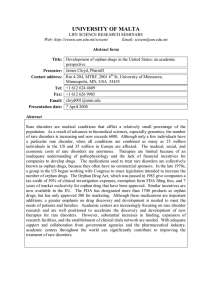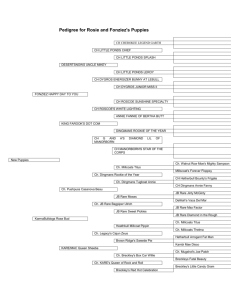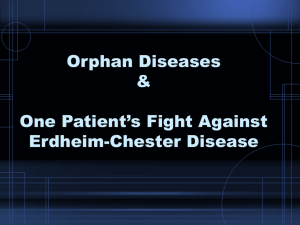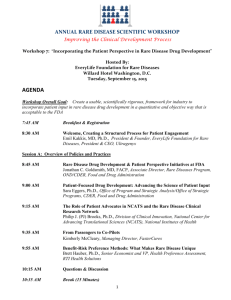Legislation and Regulatory Authorities The Orphan Drug Movement
advertisement
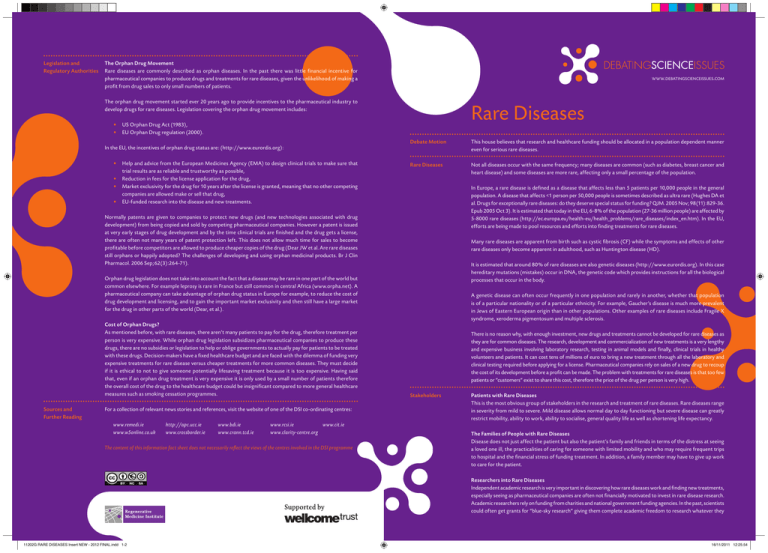
Legislation and The Orphan Drug Movement Regulatory Authorities Rare diseases are commonly described as orphan diseases. In the past there was little financial incentive for pharmaceutical companies to produce drugs and treatments for rare diseases, given the unlikelihood of making a profit from drug sales to only small numbers of patients. The orphan drug movement started ever 20 years ago to provide incentives to the pharmaceutical industry to develop drugs for rare diseases. Legislation covering the orphan drug movement includes: www.debatingscienceissues .com Rare Diseases • US Orphan Drug Act (1983), • EU Orphan Drug regulation (2000). In the EU, the incentives of orphan drug status are: (http://www.eurordis.org): •Help and advice from the European Medicines Agency (EMA) to design clinical trials to make sure that trial results are as reliable and trustworthy as possible, • Reduction in fees for the license application for the drug, •Market exclusivity for the drug for 10 years after the license is granted, meaning that no other competing companies are allowed make or sell that drug, • EU-funded research into the disease and new treatments. Normally patents are given to companies to protect new drugs (and new technologies associated with drug development) from being copied and sold by competing pharmaceutical companies. However a patent is issued at very early stages of drug development and by the time clinical trials are finished and the drug gets a license, there are often not many years of patent protection left. This does not allow much time for sales to become profitable before competitors are allowed to produce cheaper copies of the drug (Dear JW et al. Are rare diseases still orphans or happily adopted? The challenges of developing and using orphan medicinal products. Br J Clin Pharmacol. 2006 Sep;62(3):264-71). Orphan drug legislation does not take into account the fact that a disease may be rare in one part of the world but common elsewhere. For example leprosy is rare in France but still common in central Africa (www.orpha.net). A pharmaceutical company can take advantage of orphan drug status in Europe for example, to reduce the cost of drug development and licensing, and to gain the important market exclusivity and then still have a large market for the drug in other parts of the world (Dear, et al.). Cost of Orphan Drugs? As mentioned before, with rare diseases, there aren’t many patients to pay for the drug, therefore treatment per person is very expensive. While orphan drug legislation subsidizes pharmaceutical companies to produce these drugs, there are no subsidies or legislation to help or oblige governments to actually pay for patients to be treated with these drugs. Decision-makers have a fixed healthcare budget and are faced with the dilemma of funding very expensive treatments for rare disease versus cheaper treatments for more common diseases. They must decide if it is ethical to not to give someone potentially lifesaving treatment because it is too expensive. Having said that, even if an orphan drug treatment is very expensive it is only used by a small number of patients therefore the overall cost of the drug to the healthcare budget could be insignificant compared to more general healthcare measures such as smoking cessation programmes. Sources and For a collection of relevant news stories and references, visit the website of one of the DSI co-ordinating centres: Further Reading www.remedi.ie http://apc.ucc.ie www.bdi.ie www.rcsi.ie www.cit.ie www.w5online.co.uk www.crossborder.ie www.crann.tcd.ie www.clarity-centre.org The content of this information fact sheet does not necessarily reflect the views of the centres involved in the DSI programme 11202G RARE DISEASES Insert NEW - 2012 FINAL.indd 1-2 Debate Motion This house believes that research and healthcare funding should be allocated in a population dependent manner even for serious rare diseases. Rare DiseasesNot all diseases occur with the same frequency; many diseases are common (such as diabetes, breast cancer and heart disease) and some diseases are more rare, affecting only a small percentage of the population. In Europe, a rare disease is defined as a disease that affects less than 5 patients per 10,000 people in the general population. A disease that affects <1 person per 50,000 people is sometimes described as ultra rare (Hughes DA et al. Drugs for exceptionally rare diseases: do they deserve special status for funding? QJM. 2005 Nov; 98(11):829-36. Epub 2005 Oct 3). It is estimated that today in the EU, 6-8% of the population (27-36 million people) are affected by 5-8000 rare diseases (http://ec.europa.eu/health-eu/health_problems/rare_diseases/index_en.htm). In the EU, efforts are being made to pool resources and efforts into finding treatments for rare diseases. Many rare diseases are apparent from birth such as cystic fibrosis (CF) while the symptoms and effects of other rare diseases only become apparent in adulthood, such as Huntington disease (HD). It is estimated that around 80% of rare diseases are also genetic diseases (http://www.eurordis.org). In this case hereditary mutations (mistakes) occur in DNA, the genetic code which provides instructions for all the biological processes that occur in the body. A genetic disease can often occur frequently in one population and rarely in another, whether that population is of a particular nationality or of a particular ethnicity. For example, Gaucher’s disease is much more prevalent in Jews of Eastern European origin than in other populations. Other examples of rare diseases include Fragile X syndrome, xeroderma pigmentosum and multiple sclerosis. There is no reason why, with enough investment, new drugs and treatments cannot be developed for rare diseases as they are for common diseases. The research, development and commercialization of new treatments is a very lengthy and expensive business involving laboratory research, testing in animal models and finally, clinical trials in healthy volunteers and patients. It can cost tens of millions of euro to bring a new treatment through all the laboratory and clinical testing required before applying for a license. Pharmaceutical companies rely on sales of a new drug to recoup the cost of its development before a profit can be made. The problem with treatments for rare diseases is that too few patients or “customers” exist to share this cost, therefore the price of the drug per person is very high. Stakeholders Patients with Rare Diseases This is the most obvious group of stakeholders in the research and treatment of rare diseases. Rare diseases range in severity from mild to severe. Mild disease allows normal day to day functioning but severe disease can greatly restrict mobility, ability to work, ability to socialise, general quality life as well as shortening life expectancy. The Families of People with Rare Diseases Disease does not just affect the patient but also the patient’s family and friends in terms of the distress at seeing a loved one ill, the practicalities of caring for someone with limited mobility and who may require frequent trips to hospital and the financial stress of funding treatment. In addition, a family member may have to give up work to care for the patient. Researchers into Rare Diseases Independent academic research is very important in discovering how rare diseases work and finding new treatments, especially seeing as pharmaceutical companies are often not financially motivated to invest in rare disease research. Academic researchers rely on funding from charities and national government funding agencies. In the past, scientists could often get grants for “blue-sky research” giving them complete academic freedom to research whatever they 16/11/2011 12:25:54 liked, including rare diseases. These days however funding is increasingly allocated on a “greatest returns” basis, and research must have a defined goal of specified value to society. Therefore, in order to get research grants and to keep their jobs, researchers often have no choice but to direct their research towards more common diseases, which can help more people but can also yield potentially valuable patents and discoveries. Researchers are beginning to group themselves into cross institutional “research clusters” which share ideas, personnel and equipment, making more efficient use of the limited funding available for rare disease research. Pharmaceutical Companies Pharmaceutical companies are by definition profit making businesses and therefore there must be a market for the products they produce. Since rare diseases are rare, there are not many patients to create the market to pay for any treatment developed by the pharmaceutical companies. U.S. and European regulators have created special incentives to make research and production of treatments for rare diseases more attractive to pharmaceutical companies. In addition, pharmaceutical companies often list their involvement with orphan drug development as part of their corporate social responsibility strategies; much in the way that a company may advertise that it supports a certain charity. Government The majority of healthcare is paid for by the government via taxes levied on the working population of the country. It is in a country’s best interests to have a healthy population capable of working and contributing towards society. People with a serious disease, whether rare or common, require healthcare, drugs and sometimes hospitalisation; all services are at least partly-subsidised by the government. In addition if the patient cannot work, they do not pay tax and contribute to the economic stability of the country. Insurance Companies Many people have health insurance to help pay for healthcare and drugs not funded by the government. Just as governments must decide if they will fund a treatment, insurance companies must decide whether or not to cover certain drugs and treatments in their insurance plans. Patients with Common Illnesses and Diseases Sufferers of any disease, whether rare or common, have a legitimate expectation that they will be cared for by healthcare professionals and that if treatment exists, they will receive it. Patients of common diseases and their families may resent a disproportionate amount of resources being allocated to rare diseases. Politically, these patients form larger groups and therefore have a louder voice when lobbying for research and treatment into their disease to be funded. Ethical Questions There are many ethical dilemmas to be considered when funding research and treatment for rare diseases, such as: • Are resources better spent on helping a small group of people a lot or a big group of people a little? • Are people with rare diseases more or less entitled to treatment than people with common diseases? • Are diseases that are rare in rich countries more deserving than diseases that are rare in poor countries? Another key ethical question is how healthcare funds should be distributed to maximise benefit? Governments often have expert advisory boards who consider the safety, efficacy and cost-effectiveness of a drug when deciding how best to spend the money available in the healthcare budget. Governments and decision makers decide how to distribute funding using several principles (Dear JW et al. Are rare diseases still orphans or happily adopted? The challenges of developing and using orphan medicinal products. Br J Clin Pharmacol. 2006 Sep; 62(3):264-71): • Utilitarian Approach to Distributive Justice In this approach, decision makers try to bring the greatest good to the greatest number of people or to benefit society as a whole. Funding expensive drugs for rare diseases means that there is less money for more common conditions, therefore breaking the principle of reaching as many people as possible. It could even be argued that, by funding treatment for a rare disease at the expense of a common disease, patients with common diseases are somehow less worthy of treatment. 11202G RARE DISEASES Insert NEW - 2012 FINAL.indd 3-4 • The Rule of Rescue The rule of rescue is the name given to the impulse felt by people to save or not abandon other people facing avoidable death; for example, children starving to death during famine in a distant country or patients suffering from a life-threatening rare disease. EU legislation states that patients suffering from a rare condition should be entitled to the same quality of treatment as other patients. The rule of rescue highlights further ethical questions such as when does a disease becoming life threatening rather than lifespan-limiting. What about patients with rare disease that causes severe disability and pain but is not life-threatening? Facts and Figures Cystic Fibrosis (CF) CF is an incurable genetic disease which affects mainly the lungs and reduces life expectancy. Ireland has the highest rate of CF in the world with a prevalence of 3 patients per 10,000 population (Farrell PM. The prevalence of cystic fibrosis in the European Union. J Cyst Fibros. 2008 Sep; 7(5):450-3. Epub 2008 Apr 28). In recent years Irish CF patients have been vigorously campaigning for dedicated CF hospital units with individual en-suite rooms which, in other countries, have reduced cross infection and have helped improve life expectancy. Pulmozyme is an inhaled drug for CF that helps the patient breathe more easily by breaking down thick sticky mucus in the airway. Pulmozyme, an orphan drug made by Roche, significantly improves lung function and is a cornerstone of CF treatment. Pulmozyme had sales of $257 million in 2008 (http://www.gene.com/gene/ about/ir/historical/product-sales/pulmozyme.html). Huntington’s Disease Huntington’s disease (HD) is a rare genetic degenerative disease of the central nervous system that causes involuntary jerky movements, dementia, loss of body function and early death. The prevalence is Europe is 1-9 patients per 100,000 population. Symptoms appear between 30 and 50 years of age (www.orpha.net). Since HD is a genetic disease, people with a family history can choose to have a genetic test that will tell them whether or not they have the mutated gene and whether they will suffer from HD later in life. Suicide is frequent after diagnosis and in the first stages of the disease when patients begin to lose their independence. To date, no cure has been found and treatment consists of treating symptoms to improve quality of life. Stem cell therapy is an exciting potential therapy for HD and researchers have discovered how to encourage stem cells to differentiate into new neural cells but more funding and research is needed to see if this can be developed into a viable therapy for HD (http://www.eurostemcell.org/faq/what-huntingtons-disease-and-can-stem-cells-help). From an economic point of view, HD is an expensive disease because, as the disease progresses, patients need full-time care. Gaucher’s Disease Gaucher’s disease is a rare genetic disease caused by an enzyme deficiency which may result in skeletal disorders, enlarged spleen and liver, liver malfunction, anaemia, and yellow spots in the eyes. Gaucher’s disease occurs with a prevalence of 1-9 per 100,000 population (www.orpha.net) but prevalence is much higher in Jews of Eastern European descent. Enzyme replacement therapy effectively treats Gaucher’s disease and is given by intravenous drip every two weeks throughout the lifetime of the patient. Unfortunately the yearly cost of treatment can reach $400,000 per patient (Gross ML. Ethics, policy, and rare genetic disorders: the case of Gaucher disease in Israel. Theor Med Bioeth. 2002; 23(2):151-70.), forcing governments into a hard decision whether or not to fund treatment. Xeroderma Pigmentosum (XP) Xeroderma pigmentosum is a rare genetic disease that causes severe intolerance to the ultraviolet (UV) light in sunshine, patients are described as being “photosensitive”. UV light causes DNA damage in cells that can lead to skin cancer. In healthy people, DNA has a self-repairing activity that limits the damage caused by UV light and prevents cancer from starting. Patients with XP have a DNA mutation that prevents that DNA-repair mechanism from working so every time they are exposed to sunlight, DNA in their cells is damaged, leading to skin cancers. Less than half of XP patients live to see their 20th birthday. The most obvious treatment for XP is complete avoidance of sunlight. As of yet, there is no effective cure for xeroderma pigmentosum but theoretically, gene therapy delivered directly to the skin via a cream or lotion could be promising (Menck CF et al. On the search for skin gene therapy strategies of xeroderma pigmentosum disease. Curr Gene Ther. 2007 Jun;7(3):163-74). 16/11/2011 12:25:54


